On Next-Gen Audio: Legrand | AV
Alan Jacobson, Solutions Engineer at Legrand | AV shares insight into trends and best practices for implementing next-gen audio into meeting spaces and classrooms.

AVT Question: Please share insight and best practices for implementing next-gen audio into meeting spaces and classrooms.
Thought Leader: Alan Jacobson, Solutions Engineer at Legrand | AV
In the world of videoconferencing, the importance of audio should not be overlooked. While video may take the spotlight, audio quality is crucial for successful meetings or hybrid learning experiences. Here are some best practices for ensuring seamless communication.
First, avoid relying on built-in laptop microphones. Instead, opt for external table or ceiling microphones that clearly capture voices. Placing a table microphone equidistant from participants ensures equal audio quality, while ceiling microphones are ideal for larger spaces or rooms with complex seating arrangements. Ceiling microphones are a great way to reduce clutter on the table, and their placement in the room often isolates them from obtrusive sounds.
Clear and intelligible audio fosters effective collaboration, engagement, and productivity." —Alan Jacobson, Solutions Engineer at Legrand | AV
Second, consider the room’s acoustics. Modern office environments can be acoustically challenging due to excessively reflective surfaces. To mitigate this, consider microphone arrays or ceiling microphones with a built-in digital signal processor and echo cancellation for minimizing ambient noise and reverberation. These solutions enhance audio fidelity and prevent echo and feedback.
Third, laptops and personal devices may work for one-on-one conferencing, but consider incorporating external speakers to elevate the audio experience for the whole room. Soundbars or ceiling speakers provide richer and more immersive sound, allowing participants to hear every detail clearly. External speakers enhance engagement and focus during video conferences.
By implementing these audio best practices, organizations can unlock the full potential of videoconferencing. Clear and intelligible audio fosters effective collaboration, engagement, and productivity. Elevating the audio experience ensures successful and impactful videoconferencing and hybrid learning environments.
A daily selection of features, industry news, and analysis for tech managers. Sign up below.

Cindy Davis is the brand and content director of AV Technology (AVT). She was a critical member of the AVT editorial team when the title won the “Best Media Brand” laurel in the 2018 SIIA Jesse H. Neal Awards. Davis moderates several monthly AV/IT roundtables and enjoys facilitating and engaging in deeper conversations about the complex topics shaping the ever-evolving AV/IT industry. She explores the ethos of collaboration, hybrid workplaces, experiential spaces, and artificial intelligence to share with readers. Previously, she developed the TechDecisions brand of content sites for EH Publishing, named one of the “10 Great Business Media Websites” by B2B Media Business magazine. For more than 25 years, Davis has developed and delivered multiplatform content for AV/IT B2B and consumer electronics B2C publications, associations, and companies. A lifelong New Englander, Davis makes time for coastal hikes with her husband, Gary, and their Vizsla rescue, Dixie, sailing on one of Gloucester’s great schooners and sampling local IPAs. Connect with her on LinkedIn.
